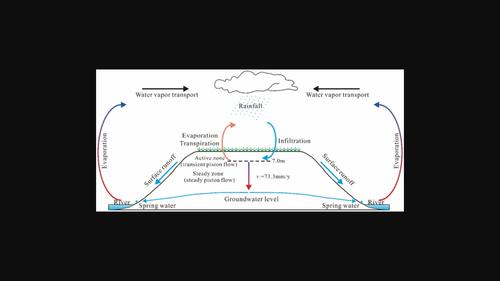当前位置:
X-MOL 学术
›
Hydrol. Process.
›
论文详情
Our official English website, www.x-mol.net, welcomes your
feedback! (Note: you will need to create a separate account there.)
Verification on the mode of moisture transfer in the vadose zone of thick loess
Hydrological Processes ( IF 2.8 ) Pub Date : 2022-07-24 , DOI: 10.1002/hyp.14656 Chenxing Wang 1 , Tonglu Li 1, 2 , Ping Li 1, 2 , Yu Wang 1 , Hua Li 1 , Yu Xi 3
Hydrological Processes ( IF 2.8 ) Pub Date : 2022-07-24 , DOI: 10.1002/hyp.14656 Chenxing Wang 1 , Tonglu Li 1, 2 , Ping Li 1, 2 , Yu Wang 1 , Hua Li 1 , Yu Xi 3
Affiliation

|
Precipitation is the only source of groundwater recharge in the Chinese loess region. However, rainfall has been the main driver of geological disasters and engineering challenges in China, such as landslides, slope collapse and sinking of foundations. The roles of preferential flow and piston flow in moisture transfer in the thick loess vadose zone remain controversial. This study used a 100-m thick loess shaft to monitor soil moisture content and soil temperature over 5 years, whereas climate indices were monitored on the Earth surface. The soil water characteristic curves and hydraulic conductivity function of the loess and the palaeosol collected in the profile were measured in a laboratory. The soil profile moisture transfer process was simulated based on the climatic boundary conditions and measured hydraulic parameters. The monitored and simulated results suggest that loess moisture transfer is dominated by piston flow. The thick loess vadose zone above the groundwater level could be divided into two sub-zones, namely the active and steady zones. The active zone has a thickness of ~7 m and shows a direct response to climate change, with soil moisture content regulated by rainfall infiltration, evaporation and transpiration and soil moisture moving as transient flow. Although preferential flow can move in the active zone along joints, fissures and holes when water accumulates in the lower ground during heavy rainfall, piston flow remains the main mode of water movement. The steady zone has a thickness of <7 m and is above the groundwater level. Soil moisture content and soil temperature in the steady zone show temporal stability and soil moisture moves as a steady flow. Piston flow is the only mode of water movement in the steady zone. Since percolation velocity in the steady zone is estimated to be 73.3 mm/year, 1330 years of rainfall infiltration through the 97.5 m thick vadose zone would be required to recharge groundwater.
更新日期:2022-07-24











































 京公网安备 11010802027423号
京公网安备 11010802027423号